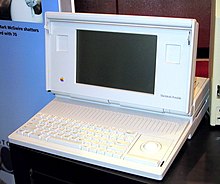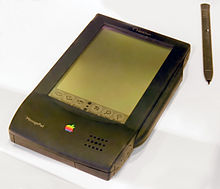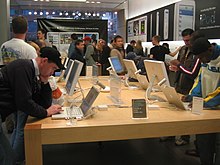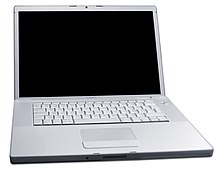1976–1980: The early years
 Apple was established on April 1, 1976 by Steve Jobs, Steve Wozniak, and Ronald Wayne, to sell the Apple I personal computer kit. They were hand-built by Wozniak and first shown to the public at the Homebrew Computer Club. The Apple I was sold as a motherboard (with CPU, RAM, and basic textual-video chips)—less than what is today considered a complete personal computer. The Apple I went on sale in July 1976 and was market-priced at $666.66 ($2,572 in 2011 dollars, adjusted for inflation.)
Apple was established on April 1, 1976 by Steve Jobs, Steve Wozniak, and Ronald Wayne, to sell the Apple I personal computer kit. They were hand-built by Wozniak and first shown to the public at the Homebrew Computer Club. The Apple I was sold as a motherboard (with CPU, RAM, and basic textual-video chips)—less than what is today considered a complete personal computer. The Apple I went on sale in July 1976 and was market-priced at $666.66 ($2,572 in 2011 dollars, adjusted for inflation.)1981–1985: Lisa and Macintosh
Steve Jobs began working on the Apple Lisa in 1978 but in 1982 he was pushed from the Lisa team due to infighting, and took over Jef Raskin's low-cost-computer project, the Macintosh. A turf war broke out between Lisa's "corporate shirts" and Jobs' "pirates" over which product would ship first and save Apple. Lisa won the race in 1983 and became the first personal computer sold to the public with a GUI, but was a commercial failure due to its high price tag and limited software titles.
In 1984, Apple next launched the Macintosh. Its debut was announced by the now famous $1.5 million television commercial "1984". It was directed by Ridley Scott, aired during the third quarter of Super Bowl XVIII on January 22, 1984, and is now considered a watershed event for Apple's succes and a "masterpiece".
1986–1993: Rise and fall
 Having learned several painful lessons after introducing the bulky Macintosh Portable in 1989, Apple introduced the PowerBook in 1991, which established the modern form factor and ergonomic layout of the laptop computer. The Macintosh Portable was designed to be just as powerful as a desktop Macintosh, but weighed 17 pounds with a 12-hour battery life. The same year, Apple introduced System 7, a major upgrade to the operating system, which added color to the interface and introduced new networking capabilities. It remained the architectural basis for Mac OS until 2001.
Having learned several painful lessons after introducing the bulky Macintosh Portable in 1989, Apple introduced the PowerBook in 1991, which established the modern form factor and ergonomic layout of the laptop computer. The Macintosh Portable was designed to be just as powerful as a desktop Macintosh, but weighed 17 pounds with a 12-hour battery life. The same year, Apple introduced System 7, a major upgrade to the operating system, which added color to the interface and introduced new networking capabilities. It remained the architectural basis for Mac OS until 2001.The success of the PowerBook and other products brought increasing revenue. For some time, it appeared that Apple could do no wrong, introducing fresh new products and generating increasing profits in the process. The magazine MacAddict named the period between 1989 and 1991 as the "first golden age" of the Macintosh.
1994–1997: Attempts at reinvention
 By the early 1990s, Apple was developing alternative platforms to the Macintosh, such as the A/UX. Apple had also begun to experiment in providing a Mac-only online portal which they called eWorld, developed in collaboration with America Online and designed as a Mac-friendly alternative to other online services such as CompuServe. The Macintosh platform was itself becoming outdated because it was not built for multitasking, and several important software routines were programmed directly into the hardware. In addition, Apple was facing competition from OS/2 and UNIX vendors like Sun Microsystems. The Macintosh would need to be replaced by a new platform, or reworked to run on more powerful hardware.
By the early 1990s, Apple was developing alternative platforms to the Macintosh, such as the A/UX. Apple had also begun to experiment in providing a Mac-only online portal which they called eWorld, developed in collaboration with America Online and designed as a Mac-friendly alternative to other online services such as CompuServe. The Macintosh platform was itself becoming outdated because it was not built for multitasking, and several important software routines were programmed directly into the hardware. In addition, Apple was facing competition from OS/2 and UNIX vendors like Sun Microsystems. The Macintosh would need to be replaced by a new platform, or reworked to run on more powerful hardware.In 1994, Apple allied with IBM and Motorola in the AIM alliance. The goal was to create a new computing platform (the PowerPC Reference Platform), which would use IBM and Motorola hardware coupled with Apple's software. The AIM alliance hoped that PReP's performance and Apple's software would leave the PC far behind, thus countering Microsoft. The same year, Apple introduced the Power Macintosh, the first of many Apple computers to use IBM's PowerPC processor.
1998–2005: Return to profitability
 On August 15, 1998, Apple introduced a new all-in-one computer reminiscent of the Macintosh 128K: the iMac. The iMac design team was led by Jonathan Ive, who would later design the iPod and the iPhone. The iMac featured modern technology and a unique design, and sold almost 800,000 units in its first five months.
On August 15, 1998, Apple introduced a new all-in-one computer reminiscent of the Macintosh 128K: the iMac. The iMac design team was led by Jonathan Ive, who would later design the iPod and the iPhone. The iMac featured modern technology and a unique design, and sold almost 800,000 units in its first five months.Through this period, Apple purchased several companies to create a portfolio of professional and consumer-oriented digital production software. In 1998, Apple announced the purchase of Macromedia's Final Cut software, signaling its expansion into the digital video editing market. The following year, Apple released two video editing products: iMovie for consumers and, for professionals, Final Cut Pro, which has gone on to be a significant video-editing program, with 800,000 registered users in early 2007. In 2002 Apple purchased Nothing Real for their advanced digital compositing application Shake, as well as Emagic for their music productivity application Logic, which led to the development of their consumer-level GarageBand application. iPhoto's release the same year completed the iLife suite.
2005–2007: The Intel transition
 At the Worldwide Developers Conference keynote address on June 6, 2005, Steve Jobs announced that Apple would begin producing Intel-based Mac computers in 2006. On January 10, 2006, the new MacBook Pro and iMac became the first Apple computers to use Intel's Core Duo CPU. By August 7, 2006 Apple had transitioned the entire Mac product line to Intel chips, over one year sooner than announced. The Power Mac, iBook, and PowerBook brands were retired during the transition; the Mac Pro, MacBook, and MacBook Pro became their respective successors. On April 29, 2009, The Wall Street Journal reported that Apple was building its own team of engineers to design microchips.
At the Worldwide Developers Conference keynote address on June 6, 2005, Steve Jobs announced that Apple would begin producing Intel-based Mac computers in 2006. On January 10, 2006, the new MacBook Pro and iMac became the first Apple computers to use Intel's Core Duo CPU. By August 7, 2006 Apple had transitioned the entire Mac product line to Intel chips, over one year sooner than announced. The Power Mac, iBook, and PowerBook brands were retired during the transition; the Mac Pro, MacBook, and MacBook Pro became their respective successors. On April 29, 2009, The Wall Street Journal reported that Apple was building its own team of engineers to design microchips.2007–present: Post-PC era
In an article posted on Apple's website on February 6, 2007, Steve Jobs wrote that Apple would be willing to sell music on the iTunes Store without DRM (which would allow tracks to be played on third-party players) if record labels would agree to drop the technology. On April 2, 2007, Apple and EMI jointly announced the removal of DRM technology from EMI's catalog in the iTunes Store, effective in May. Other record labels followed later that year.
On January 17, 2011, an internal Apple memo from Jobs announced that he will once again take a medical leave of absence, for an indefinite period, to allow him to focus on his health. Chief operating officer Timothy D. Cook will take up Jobs' day-to-day operations at Apple, although Jobs will still remain "involved in major strategic decisions for the company."
After Apple Inc. surpassed Microsoft in market capitalization in 2010, Apple Inc. has also become the most valuable consumer-facing brand in the world with a 246 percent increased to $19.1 billion.
sources : www.wikipedia.com












No comments:
Post a Comment